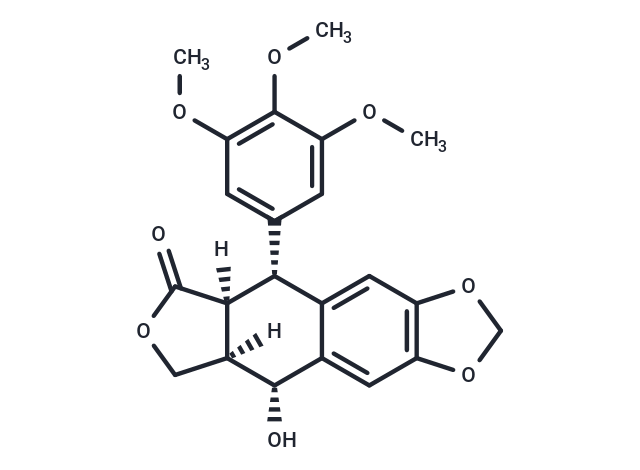Shopping Cart
- Remove All
 Your shopping cart is currently empty
Your shopping cart is currently empty

Picropodophyllin (Picropodophyllin (PPP)) (PPP) is a specific IGF-1R inhibitor (IC50: 1 nM). Picropodophyllin specifically inhibits the activity and downregulates the cellular expression of IGF1R without interfering with activities of other growth factor receptors, such as receptors for insulin, epidermal growth factor, platelet-derived growth factor, fibroblast growth factor and mast/stem cell growth factor (KIT).

| Pack Size | Price | Availability | Quantity |
|---|---|---|---|
| 5 mg | $58 | In Stock | |
| 10 mg | $80 | In Stock | |
| 25 mg | $178 | In Stock | |
| 50 mg | $333 | In Stock | |
| 100 mg | $563 | In Stock | |
| 500 mg | $1,180 | In Stock | |
| 1 mL x 10 mM (in DMSO) | $63 | In Stock |
| Description | Picropodophyllin (Picropodophyllin (PPP)) (PPP) is a specific IGF-1R inhibitor (IC50: 1 nM). Picropodophyllin specifically inhibits the activity and downregulates the cellular expression of IGF1R without interfering with activities of other growth factor receptors, such as receptors for insulin, epidermal growth factor, platelet-derived growth factor, fibroblast growth factor and mast/stem cell growth factor (KIT). |
| Targets&IC50 | IGF-1R:1 nM |
| In vitro | In intact cells, PPP efficiently inhibits IGF-1-stimulated IGF-1R, Akt (Ser 473) and Erk1/2 phosphorylation. Picropodophyllin specifically inhibits cell growth, and induces apoptosis in cultured IGF-1R-positive tumor cells. [1] Picropodophyllin synergistically sensitizes HMCL, primary human MM and murine 5T33 mM cells to ABT-737 and ABT-199 by further decreasing cell viability and enhancing apoptosis. [3] Picropodophyllin and sorafenib synergistically suppress the proliferation and motility of hepatocellular carcinoma cells. [4] |
| In vivo | In SCID mice xenografted with human ES-1, BE, and PC3, Picropodophyllin (20 mg/kg/12 h, i.p.) causes complete tumor regression. [1] In the 5T33 mM mouse model, Picropodophyllin also shows a marked antitumor activity, and causes a significant increase in survival. [2] |
| Kinase Assay | In vitro tyrosine kinase assays.: Assay of IGF-1R-catalyzed substrate phosphorylation of pTG, using a 96-well plate tyrosine kinase assay kit, is performed. We use recombinant epidermal growth factor receptor, immunoprecipitated IR from HEPG2, immunoprecipitated IGF-1R from P6 cells, and IGF-1R immunodepleted supernatant from P6 (representing "non-IGF-1R tyrosine kinases"). After 30-min treatment of the receptors with the desired compounds in the kinase buffer [50 mM HEPES buffer (pH 7.4), 20 mM MgCl2, 0.1 MnCl2, and 0.2 Na3VO4], the kinase reaction is activated by addition of ATP. The phosphorylated polymer substrate is probed with a phosphotyrosine-specific monoclonal antibody conjugated to horseradish peroxidase, clone PT-66. Color is developed with horseradish peroxidase chromogenic substrate O-phenylenediamine dihydrochloride and quantitated by spectrophotometry (ELISA reader). IGF-1R tyrosine autophosphorylation is analyzed by a sandwich ELISA assay. Briefly, 96-well plates are coated overnight at 4°C with 1 μg/well of an antibody to IGF-1R β-subunit. The plates are blocked with 1% BSA in PBS Tween for 1 h, and then 80 μg/well of total protein lysate from the P6 cell line is added. As a negative control we use total protein lysate from the R- cell line. The investigated compounds are added in tyrosine kinase buffer without ATP at room temperature for 30 min before kinase activation with ATP. Kinase assay is performed using the Sigma kit (see above). After spectrophotometry the IC50 values of inhibitors are determined using the REGRESSION function of Statistica program. |
| Cell Research | The determinations are performed using the Cell proliferation kit II, which is based on colorimetric change of the yellow tetrazolium salt 2,3-bis[2-methoxy-4-nitro-5-sulfophenyl]-2H-tetrazolium-5-carboxanilide inner salt in orange formazan dye by the respiratory chain of viable cell. All of the standards and experiments are performed in triplicates. (Only for Reference) |
| Alias | PPP, Picropodophyllotoxin, AXL1717 |
| Molecular Weight | 414.41 |
| Formula | C22H22O8 |
| Cas No. | 477-47-4 |
| Smiles | [H][C@]12COC(=O)[C@@]1([H])[C@H](c1cc(OC)c(OC)c(OC)c1)c1cc3OCOc3cc1[C@@H]2O |
| Relative Density. | 1.37g/cm3 |
| Storage | Powder: -20°C for 3 years | In solvent: -80°C for 1 year | Shipping with blue ice. | ||||||||||||||||||||||||||||||||||||||||
| Solubility Information | H2O: < 1 mg/mL (insoluble or slightly soluble) DMSO: 55 mg/mL (132.72 mM), Sonication is recommended. Ethanol: 1 mg/mL (2.41 mM), Heating is recommended. | ||||||||||||||||||||||||||||||||||||||||
Solution Preparation Table | |||||||||||||||||||||||||||||||||||||||||
Ethanol/DMSO
DMSO
| |||||||||||||||||||||||||||||||||||||||||

Copyright © 2015-2025 TargetMol Chemicals Inc. All Rights Reserved.